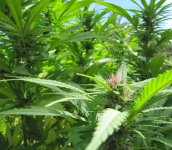Hello everyone,
I am a bit stuck with this issue of genetic population scale and diversity.
Always more, I am moving on the path of growing for diversity, which may sounds silly for some, but make somehow sense for me
I recently bought 1 pack of black widow and I am thinking how to enjoy this genetic, but at the same time trying to conserve and preserve some of the hard work that has been done until now. A F2 generation would be a reasonable decision ( open or selected pollination) keeping an open pool genetic of the WW.
But which diversity am I really preserving in 1 pack of seeds?
Let's add a parameter to this question: for some reason I have only 1 pack of seeds, no 2,3 no 100 seeds.1 pack.
How can I create diversity and preserve the genetic?
Migration could be a possibility, but if I have only 1 pack doesn't work.
I would exclude mutations.
I would like to avoid crossbreeding which is inbreeding.
I could outbreed crossing it with something else. This is actually the only possibility to create and preserve a genetic in small populations, isn't?
What's your thoughts about this topic?
Do you have any other suggestion?
Thanks
R
I am a bit stuck with this issue of genetic population scale and diversity.
Always more, I am moving on the path of growing for diversity, which may sounds silly for some, but make somehow sense for me
I recently bought 1 pack of black widow and I am thinking how to enjoy this genetic, but at the same time trying to conserve and preserve some of the hard work that has been done until now. A F2 generation would be a reasonable decision ( open or selected pollination) keeping an open pool genetic of the WW.
But which diversity am I really preserving in 1 pack of seeds?
Let's add a parameter to this question: for some reason I have only 1 pack of seeds, no 2,3 no 100 seeds.1 pack.
How can I create diversity and preserve the genetic?
Migration could be a possibility, but if I have only 1 pack doesn't work.
I would exclude mutations.
I would like to avoid crossbreeding which is inbreeding.
I could outbreed crossing it with something else. This is actually the only possibility to create and preserve a genetic in small populations, isn't?
What's your thoughts about this topic?
Do you have any other suggestion?
Thanks
R

